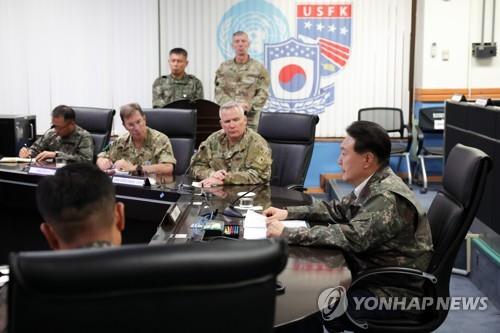- S. Korea unveils first graphic cigarette warnings
- US joins with South Korea, Japan in bid to deter North Korea
- LPGA golfer Chun In-gee finally back in action
- S. Korea won’t be top seed in final World Cup qualification round
- US men’s soccer misses 2nd straight Olympics
- US back on track in qualifying with 4-0 win over Guatemala
- High-intensity workout injuries spawn cottage industry
- CDC expands range of Zika mosquitoes into parts of Northeast
- Who knew? ‘The Walking Dead’ is helping families connect
- California Assembly OKs highest minimum wage in nation
Yoon visits wartime bunker to monitor joint S. Korea-U.S. military exercise
President Yoon Suk Yeol visited a key U.S.-controlled wartime command bunker complex on Wednesday to examine South Korean and U.S. troops engaging in an annual joint military exercise, according to his spokesperson.
Yoon’s trip to CP Tango, or the Command Post Theater Air Naval Ground Operations, in Seongnam, just south of Seoul, came on the third day of the ongoing Ulchi Freedom Shield (UFS) exercise between the two countries running for 11 days.
“CP Tango has served as the brain commanding three military branches of both countries during wartime since the establishment of the South Korea-U.S. Combined Forces Command in 1978,” Yoon was quoted by presidential spokesperson Lee Do-woon as saying.
It marks the first time since former President Park Geun-hye’s visit in 2013 that a sitting president has visited the wartime bunker nestled in the mountains.
Yoon also said that North Korea’s nuclear and missile threats are the most serious, adding that provocations are becoming more sophisticated and versatile through cyber attacks and psychological warfare.
The North has notified Japan of its plan to launch a satellite between Thursday and Aug. 31, according to a Japanese news report. The launch window overlaps with the UFS, as North Korea has long denounced Seoul-Washington joint military drills as a rehearsal for invasion.
The bunker complex serves as the primary command and control center for South Korean and U.S. forces in the event of an armed conflict. It is known to be strong enough to survive a tactical nuclear attack.












